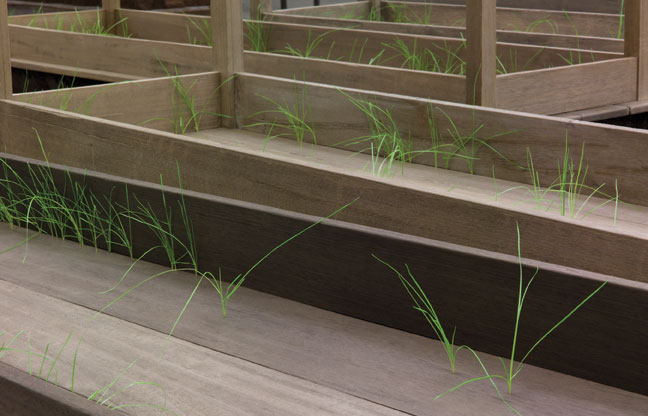« Reviews
Doris Salcedo
Pérez Art Museum Miami
By Heike Dempster
With “Doris Salcedo,“ Pérez Art Museum Miami presents three decades of the artist’s sculptures and installations. The first retrospective of the work of the renowned Colombian artist is organized by the MCA Chicago and covers the artist’s penchant for fusing post-minimalist forms with cultural concerns. Deeply rooted in Colombia’s social and political landscape, including its long history of civil conflicts, Salcedo’s work examines trauma, violence, loss, social injustice and marginalization with sophistication, intimate understanding of the victims as well as a poetic sensibility that balances the gravitas of her subjects.
Salcedo’s oeuvre is defined by meticulous execution, a distinct material vocabulary, a deep understanding of the materials and their connotations, as well as extensive research, which involves meetings with the relatives of victims of violence and people who have experienced loss to truly understand the grieving process and the socioeconomic and geographic factors that may affect it. This process imbues her work with an intimate connection to the personal that speaks to collective experiences and universal emotions.
A documentary film focusing on Salcedo’s public projects serves as introduction to the exhibition before visitors walk through the installation Plegaria Muda, a labyrinthine arrangement of handcrafted tables that leads into the main exhibition space. The tables, sized to resemble coffins, are layered with earth and grass sprouts from within, suggesting the continuity of life. This initial sense of hope heightens the impact of feelings of sadness, gloom and emptiness that strikes the viewer upon entering. Everything seems somehow weathered and damaged. As one wanders through the separated spaces the galleries seem haunted and one is overcome by a deep sense of loss.

Doris Salcedo, Plegaria Muda (detail), 2008–10, wood, concrete, earth, and grass, one hundred and sixty-six parts, each: 64-5/8” x 84-1/2” x 24.” Overall dimensions variable. Installation view, MUAC, Mexico City, 2011, Inhotim Collection, Brazil. Photo: Jason Mandella. Courtesy of White Cube.
Seemingly old wooden furniture is spaced throughout the galleries. No one is here. Whoever lived here is gone. Chairs conjure human bodies, suggestive of what once was. A little child’s dress, yellowed from years of being stowed away, brings images of play and laughter that has left these walls long ago. Everyone is gone, dead or missing. Some of the furniture is weighed down with concrete. Fractured tables, interlaced with human hair, speak of disrupted lives and allude to broken family homes and displacement. Shoes hidden behind yellow-tinted windows made of cow bladders with visible stitching are buried in the walls of the museum like artifacts, hinting at something uncomfortable and not quite tangible. Who wore these shoes? What stories are trapped in those walls?
Salcedo conveys intense, painful and troubling emotions as she explores loss and trauma beyond her own experiences. The artist manages to present work so nuanced it connects with humanity on a deeper level by accessing shared and transcending emotions. The exhibition contains no trace of literal representation of any violence or trauma, but rather pieces that engage the viewer in an open-ended and personal dialogue. Each viewer has to grapple with the feelings brought on by Salcedo’s work. There is no space for intentional fallacy as the empty space-the literal and conceptual-is filled with the viewer’s reactions, feelings, thoughts, fears and hopes.
Salcedo’s interest is twofold. First, there is an investigation into the personal and intimate feelings of loss, and trauma as experienced by an individual. Secondly, there is the pain and trauma caused by social injustice such as racism or colonialism, marginalization and large-scale trauma suffered by a people. Personal trauma affects society at large, and large-scale trauma of a community or people affects the individual.
The artworks attempt the difficult task of recovering individual dignity for these victims by giving presence to absent bodies and those invisible to society, those who are marginalized and have no voice. The emptiness is where the victims can share their stories, urging the viewer to fill a void and enter into a dialogue with the art. One starts to search for the missing, for the invisible, for the ones who are gone forever. One starts to question what is no longer here. One starts to seek answers, seek relief from pain. Yet the art does not provide the answers. Salcedo does not offer a concrete answer but rather urges us to endure and walk through the galleries and actively experience these feelings of emptiness, grief and hope.
(April 20 - July 17, 2016)
Filed Under: Reviews



































Leave a Reply
You must be logged in to post a comment.